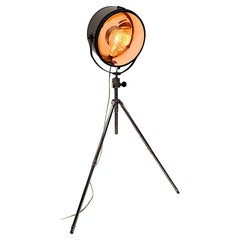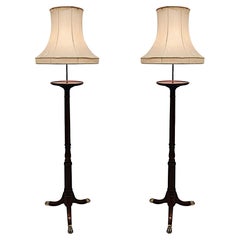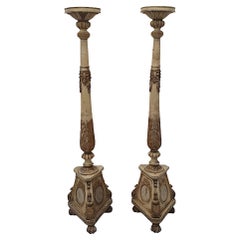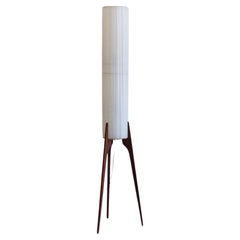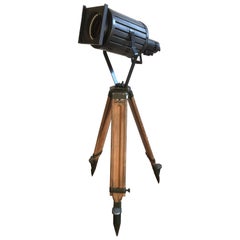Yeats Country Antiques Floor Lamps
to
3
Height
to
Width
to
1
2
2
1
1
2
2
1
1
1
3
2
2
1
3
3
3
Vintage Spot Light on 1960's Aluminium Tripod
Located in Dublin, IE
An unusual vintage spot light, this fabulous piece features a black metal head and is mounted on an adjustable 1960's aluminium tripod stand.
Dim...
Category
Mid-20th Century English Floor Lamps
Materials
Metal, Aluminum
A Very Rare Pair of 19th Century Plant Stands / Torcheres Converted to Lamps
Located in Dublin, IE
A very rare pair of 19th Century richly patinated mahogany plant stands or torcheres converted to standard lamps, finely hand carved and of exceptional quality. The well figured, mo...
Category
Antique 19th Century English Floor Lamps
Materials
Brass
Very Rare and Unusual Pair of 19th Century Parcel Gilt Torcheres
Located in Dublin, IE
A very rare and unusual pair of 19th century hand painted and gilded torcheres in original condition, finely hand carved and adorned with beautiful mo...
Category
Antique 19th Century French Torchères
Materials
Wood, Giltwood, Paint
Related Items
Vintage Danish Tripod Rocket Floor Lamp, 1960s.
Located in Asaa, DK
Vintage Danish Tripod Rocket Floor Lamp, 1960s.
Mid-Century space age "Rocket" floor lamp, Denmark, 1960s.
Three legged teak base with tapered legs. Tal...
Category
Vintage 1960s Danish Scandinavian Modern Floor Lamps
Materials
Teak
Vintage Black Theater Tripod Lamp, 1960s
Located in Kojetice, CZ
- Vintage theatre spotlight on wooden tripod made during the 1960s
- Adjustable height and angle
- Black metal body
- Clear magnifying glass
- Dimensions of the lamp: 21 x 21 cm,...
Category
Vintage 1960s European Industrial Floor Lamps
Materials
Iron
Superior Pair of 19th Century Patinated & Parcel Gilt Bronze Figural Candelabra
By Claude Michel Clodion
Located in Ottawa, Ontario
An exceptionally fine pair of 19th century patinated & parcel gilt bronze figural candelabra, executed in the Rococo manner closely associated with works by Claude Michel (Clodion) 1...
Category
Antique Late 19th Century French Rococo Revival Candelabras
Materials
Marble, Bronze
$5,250 Sale Price / set
25% Off
H 13.5 in W 9.25 in D 5.75 in
Naturalistic Plant Stand Floor Lamp attributed to Salterini
By John Salterini
Located in New York, NY
Stylish wrought and cast iron floor lamp, plant stand, in original faux verdigris finish. This interesting floor lamp has four arms, or branches, which support small ( 5.5 inch total...
Category
Mid-20th Century American Mid-Century Modern Floor Lamps
Materials
Iron
Pair of French 19th-20th Century Neoclassical Style Cast Iron Figural Torchères
Located in Los Angeles, CA
A very fine pair of French 19th-20th century neoclassical style patinated cast iron figural torchères by A. Durenne, Paris, each representing a figure of a standing young maiden, her arms raised forward while holding a a flaming urn gas light (Now electrified) with a frosted glass flame, each raised on a veined grey marble column stand, both cast-signed 'A. Durenne, Paris'. Antoine Durenne was an internationally renowned French art founder. He attended École Nationale Supérieure des Beaux-Arts in 1842. Durenne purchased a small foundry in Sommevoire, near the Val d'Osne, Haute-Marne, France and established The Durenne firm, circa Paris, 1900.
Cast-iron had been in production during the 18th century but its inferior status to the more fashionable and delicate wrought iron had generally confined its use to architectural work. By the early 19th century, however, rapid developments of the Industrial Revolution combined with the simultaneous burgeoning of a new middle class provided the impetus for a dramatic Expansion in its application and in a short space of time a proliferation of iron foundries across Europe and America thrived on the production of everything from inkstands to railway stations. The use of cast-iron for garden ornament became particularly widespread at this time, as the possibilities for its mass-production at a fraction of the cost of bronze made it the material of choice for outdoor statuary...
Category
Antique Early 1900s French Neoclassical Revival Figurative Sculptures
Materials
Marble, Iron
$49,875 Sale Price / set
41% Off
H 71 in W 29 in D 27.5 in
Pair French 19th-20th Century Neoclassical Style Iron and Parcel-Gilt Torcheres
Located in Los Angeles, CA
A Palatial Pair of French 19th/20th Century Neoclassical Revival Style Ebonized Cast-Iron and Parcel-Gilt Torcheres (torchières - Lamp Posts). The park-like torcheres surmounted with...
Category
Antique Early 1900s French Neoclassical Revival Floor Lamps
Materials
Iron, Zinc
$19,850 Sale Price / set
30% Off
H 102 in Dm 29 in
Wooden Tripod Gray Enamel Vintage Industrial Spot Light Floor Lamps
Located in Amsterdam, NL
Wooden army tripod with dark green ironwork incl. industrial spot.
Adjustable height and angle gray enamel spot. White interior.
Measures: Diameter 35 cm. Max tripod height 140 cm....
Category
Mid-20th Century Czech Industrial Floor Lamps
Materials
Enamel, Iron
$1,161 / item
H 70.87 in Dm 13.78 in
Vintage Mole-Richardson Type 407 Baby Solarspot Spot Stage Light Floor Lamp
Located in Lafayette, IN
Vintage type 407 baby solarspot stage light by Mole-Richardson of Hollywood, CA.
This fantastic light is in 90% original condition with some light poli...
Category
Vintage 1960s American Industrial Floor Lamps
Materials
Bronze, Steel
$879 Sale Price
20% Off
H 48 in Dm 36 in
Pair of 18th Century Italian Gilt Wood Pricket Floor Candlesticks
Located in Sheffield, MA
Outstanding 18th century, Italian carved and giltwood altar sticks with circular tops, carved applied putti decoration and scrolled feet. Some paint losses, repairs and varying degre...
Category
Antique 18th Century and Earlier Italian Rococo Candle Holders
Materials
Wood, Paint
$7,800 / set
H 40.25 in W 19.25 in D 9.5 in
Pair of 19th-Century Italian Polychrome and Parcel-Gilt Altar Prickets
Located in Rio De Janeiro, BR
Pair of 19th-Century Italian Polychrome and Parcel-Gilt Altar Prickets
A graceful pair of 19th-century Italian altar prickets, hand-carved in wood with their original polychrome and ...
Category
Antique 1880s Italian Empire Revival Candlesticks
Materials
Wood
$2,600 / set
H 30.71 in W 9.85 in D 9.85 in
An Italian 19th Century Patinated Bronze Torchere, After Niccolò Roccatagliata
By Niccolo Roccatagliata
Located in Los Angeles, CA
A Large and Impressive Italian 19th Century Patinated Bronze Figural Torchere, after a model by Niccolò Roccatagliata (Genoa 1593 - Venice 1636). The triangular foot base with projecting putti supporting the stem and oval reserves within cartouche motifs, one containing the initials "S.D" with an olive tree in-between and a bull-head below. The stem knot with figures of winged caryatids and festoons and upper part with cherub heads, acanthus leaves and egg and bead patterns and topped with a later white glass globe. The decorative system refers to the documented artistic production of the Venetian workshop of Niccolò Roccatagliata and takes inspirational model from the base of the Renaissance bronze of the Scuola Grande di San Teodoro in Venice, a work signed by Andrea del Bartolomeo di Alessandri known as Brescianino. Electrified. Circa: Venice, 1850-1880.
RELATED LITERATURE
L. Planiscig, Venezianische Bildhauer der Renaissance, Vienna, 1921, figs. 661-664; C. Avery, 'Andrea del Bartolomeo di Alessandri detto il Bresciano" lavator di gettar di Bronzo": candelabri, satiri e battenti', M. Ceriana and V. Avery (eds.), L'Industria artistica del Bronzo del Rinascimento a venezia e nell'Italia settentrionale, Venice, 2008, pp. 233-252.
Similar models of this torchere were part of the interior decor collection at the Vanderbilt Mansion in New York (see black and white photo). The Cornelius Vanderbilt II House was a large mansion built in 1883 at 1 West 57th Street in Manhattan, New York City. It occupied the frontage along the west side of Fifth Avenue from West 57th Street up to West 58th Street at Grand Army...
Category
Antique 19th Century Italian Baroque Floor Lamps
Materials
Bronze
$14,850 Sale Price
69% Off
H 66.5 in W 19.25 in D 18 in
Green Metal Vintage Industrial Clear Glass Wooden Tripod Spot Light Floor Lamp
Located in Amsterdam, NL
Vintage industrial spotlight on green wooden tripod.
Adjustable height and angle.
Green aluminium spot with clear glass. Diameter 30 cm.
Depth 47 cm. maximum tripod height without l...
Category
Mid-20th Century Polish Industrial Floor Lamps
Materials
Iron
$1,216
H 76.78 in W 11.82 in D 18.51 in
